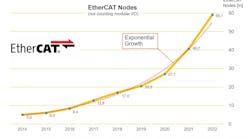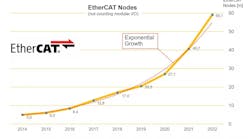EtherCAT Reaches Almost 60 Million Nodes
For the first time since EtherCAT was introduced 20 years ago, the EtherCAT Technology Group (ETG) published node figures. Excluding modular I/O devices, ETG counts 59.1 million nodes, with recent growth being particularly impressive. More than 18 million nodes were added in 2022 alone.
These figures include EtherCAT chips sold in a respective year, though this does not include the chips for I/O terminals. This means that a modular I/O station counts as a single node, even if it consists of many more EtherCAT terminals.
"The chip numbers are accurate figures, but there is a certain time lag: not every chip becomes an installed EtherCAT device in the same calendar year," said Martin Rostan, executive director of the ETG, who is also in charge of all EtherCAT licensing, on the behalf of Beckhoff Automation.
EtherCAT is the industrial Ethernet technology introduced in 2003 and has been an international IEC standard and a SEMI standard since 2007. EtherCAT is an open technology. In the ETG, more than 7,000 user companies from various industries and automation suppliers join forces to support, promote and advance the technology.
EtherCAT, similar to controller area network (CAN), requires only the chip manufacturer to license the hardware, so the cost is included in the purchase of the EtherCAT chips. Beckhoff finances the ETG with the chip license income, and membership in the fieldbus association is free of charge as a result.
Because it doesn’t know the exact unit numbers of field-programmable-gate-array (FPGA) intellectual-property (IP) core-based implementations, ETG has held back on publishing node numbers, Rostan said. "But the reported unit numbers of the current 12 EtherCAT chip vendors are now so large that any possible fuzziness in estimating FPGA numbers is no longer a factor,” he explained. “They enter the totals at less than 10%. We have also included multiprotocol chips in proportion to the market share of the protocols. Thus, the figures are based on very reliable sources, and they are determined very conservatively: there are probably significantly more EtherCAT devices."
Except for 2019, when the automation market’s turbulence also affected EtherCAT unit numbers, growth has been exponential for several years, explained Rostan. "Three years ago, we still believed in an upward outlier, but now the trend has solidified: the exponential growth continues," he added. "The Asian market is developing the fastest, especially in China. But EtherCAT is also making better progress in North America. And in Europe, where the technology has its origins, EtherCAT has been going strong for quite some time."
This article appeared in Control Design, an affiliate publication of Machine Design.

